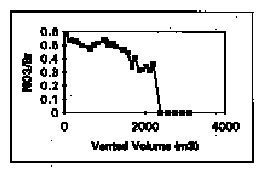
The Coët-Dan drainage basin in Brittany is the scene
of intensive farming, which induces high levels of nitrate contamination in surface waters. In the aquifer, large variations of concentration-versus-depth are observed; within its upper zone, the fluids are strongly contaminated, with nitrate concentrations of as much as 200 mg/l, but which sharply decrease with depth. This decrease is, at least in part, interpreted by denitrification that is influenced by two mechanisms: (a) the mineralization of organic matter; (2) the oxidation of pyrite (detected in cutting samples collected during drilling). To obtain a better information of denitrification reactions, the chemical parameters of groundwater have been monitored in a small area of the drainage baisn since December 1994 and tracer experiments, including injection of nitrate, were conducted.
From a hydro-chemical viewpoint, the basin consists of two units. From 0 to ~10m, the fluids are more mineralized than deeper down, with chloride contents of around 53 mg/l, and have the highest nitrate concentration, up to 200 mg/l. Variations of nitrate concentration over time are observed, the lowest concentration being reached during autumn, while very low to nil concentrations are registered in the river. At deeper levels, the mineralization and nitrate concentration sharply decrease; chloride concentration drops to 23 mg/l and the nitrate content decreases to zero. These fluids are enriched in CO2 and SO4, which can be attributed to both autotrophic and heterotrophic denitrification processes. In the deeper fluids, variations of nitrate concentrations versus time do not correlate with the values observed in surface waters. Maximum concentration occurs in late spring, whereas in the surface waters it occurs during winter. Exchanges between both shallow and deep levels exist, but are discontinuous in time. As nitrate is periodically observed down to the maximum observation depth of 100 m, nitrate transfer should be rapid with respect to the denitrification rate. In any case, the fluid circulation through this fissured medium must be rapid, which induces a rapid transfer of nitrates.
Two types of tracer experiments were conducted in the lower part of the aquifer where denitrification reactions occur, based on the simultaneous injection of nitrate and bromide (as a conservative tracer): (1) injection into a single well from which the fluids were pumped after 2.5 days of interaction, and (2) a radially converging flow experiment between two wells spaced at 15 m. In the latter case, the tracers appear in the pumping well around 6 hours after their injection. Comparison between bromide and nitrate recoveries shows that the fluids are rapidly depleted in NO3 with respect to Br (Fig. 1). This indicates that the denitrification reaction is rapid, starting after only a few hours, and is completed after a few days of reaction time.
In the Coët-Dan drainage basin, nitrate is transferred from shallow highly contaminated groundwater to the deeper levels of the aquifer. Although denitrification reactions are very rapid in the deep aquifer level, the transfer rate through the fissured medium is sufficiently high to detect nitrates during some periods of the year.
Fig. 1: Nitrate relative to bromide concentrations (g/g) versus vented volume during single well experiment.